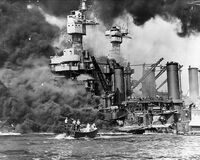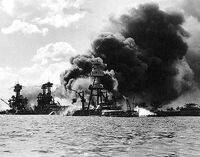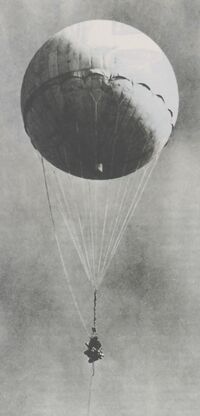Attacks on North America during world War || from the Axis Power were quite uncommon. This was because of the separation from Asia and Europe where the conflicts were generally taking place. The attacks generally began from the attack on Pearl Harbor, which technically was not an attack on North America, as Hawaii was not yet a United States territory.

Pearl Harbor under attack
Japanese Attacks[]
Ellwood shelling[]
The United States was first attacked by the Axis on February 23, 1942. The conflict began when the submarine |-17 assaulted the Ellwood oil field in California. Damages were minimal, with only a $500–$1000 rate in damage repairs. No casualties were reported, however, the invasion scare along the west coast began.
Battle of the Aleutian Islands[]
On June 3, 1942, the Aleutian islands southwest from Alaska were invaded by Japanese forces. The United States knew the attack would be coming, however did not utilize many troops for defense. Instead, many Americans moved to camps in southern Alaska. However, some Americans were captured and became prisoners of war.
In the battle, Americans engaged Japanese on Attu island, and recaptured it in the end of May, 1943, after many deaths. Although not yet a state to the USA until 1959, Alaska was part of North America all the same.
Assault on Estevan Point lighthouse[]
On June 20, 1942, the Japanese submarine I-26, under Yokota Minoru, fired on Estevan Point lighthouse in British Columbia, but missed it's target. This marked the first enemy shelling of Canada since the War of 1812. No casualties were reported to this attack.
Fort Stevens attack[]

Fort Stevens Attack
The fort Stevens attack was the only attack on an American military installation during world war 2. The Japanese submarine |-25 surfaced in the Columbia river, and fired upon Fort Stevens. The submarine was spotted, and attacked by a US bomber, but it escaped.
Air Raid[]
The Lookout Air Raid occurred on September 9, 1942. This was the first, and as of today only Aerial bombing in America by Foreign power. This was an attempt to cause a forest fire. No significant damage was reported from this assault.
Balloon attack[]

A Japanese fire balloon
In the vicinity of November 1944 and April 1945, Japan launched over 9,000 fire balloons toward North America. These were carried by the pacific jet stream. These balloons landed in North America, hoping to cause forest fires, and other various damage. Casualties were minimal-Six people (five children and a woman) became the only deaths due to enemy action to occur on mainland America during World War II when one of the children tampered with a bomb from the balloon near Bly, Oregon in the United States and it exploded.
German Attacks[]
US landings[]
Duquesne Spy Ring[]
The Duquesne Spy Ring was and is the largest espionage case in USA history. The Germans who were in this ring had key jobs, where they could plan sabotage to befall the USA. The ring was led by Captain Fritz Joubert Duquesne, who spied for the Germans in both world wars. William G. Sebold, a double agent for the United States, was a major factor in the FBI's successful resolution of this case. For nearly two years, Sebold ran a radio station in New York for the ring, giving the FBI valuable information on what Germany was sending to its spies in the United States.
Operation Pastorius[]
When the United States entered World War II, Adolf Hitler ordered the remaining German saboteurs to wreak havoc on the country. Eight agents were involved into this, divided into two groups. On June 12, 1942, U-Boat U-202 landed Dasch's team with explosives and plans at East Hampton, Long Island, New York. However, Dasch decided to turn himself into the FBI. He supplied them with everything he knew, which led to the arrest of his complete team. His confession also led to the capture of the other team.
All of these men were trialed, with 6 sentenced to death.
Operation Elster[]
There was yet another attempt at infiltration. Elster involved Erich Gimpel and German American defector William Colepaugh. The mission objective was to gain intelligence However, this ended in failure. both were sentenced to death.
German assaults in Canada[]
St. Martins[]
During the Dashce operation, an Abweher agent was landed near New Brunswick. His mission was to observe and report the doigns of the shipping of the company Halifax. However, the agent decided to change hiself, by turning hiself in to the Canadian authorities.
New Carlisle[]
During November, The U-boat U 518 sank to oil freighters near New Carlisle, and damaged one nearby Newfoundland. From this, a spy was also able to have been dropped off. However, this spy was quickly captured. The spy was then converted, and made a double agent to gain intelligence.
Martin Bay[]
On the date of 18 September 1943, U-537 sailed from Kiel, via Bergen (Norway), with a meteorological team lead by Professor Kurt Sommermeyer. They landed near a port in Labrador on 22 of October. They managed to set up a weather Station. This was soon discovered, and stopped.